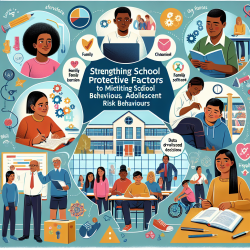Introduction
In the realm of adolescent development, the interplay between family and school environments is crucial in shaping behavioral outcomes. Recent research underscores the pivotal role of school protective factors in mitigating risk behaviors among adolescents. This blog explores the findings from the study "The Importance of Family and School Protective Factors in Preventing the Risk Behaviors of Youth" and discusses how practitioners can leverage these insights to enhance their practice.
Understanding the Research
The study, conducted among 9,682 adolescents in Croatia, aimed to examine the associations of family and school protective factors with adolescent risk behaviors such as substance use, violence, gambling, and sexual risk behavior. The research utilized multigroup structural equation modeling to analyze relationships between variables like school attachment, school commitment, family communication, and family satisfaction.
Key findings highlighted that school protective factors, particularly school attachment and commitment, had more significant negative associations with risk behaviors compared to family factors. For instance, increased school attachment was linked to decreased gambling and violence, while school commitment was inversely related to gambling, substance use, and violence.
Implications for Practitioners
For practitioners working in educational settings, these findings offer valuable insights into designing interventions that foster school protective factors. Here are some actionable strategies:
- Enhance School Attachment: Develop programs that strengthen students' emotional connections to their school environment. Activities that promote positive student-teacher relationships and a sense of belonging can be effective.
- Promote School Commitment: Encourage academic engagement by recognizing student efforts and achievements. Tailor interventions to support students in setting and achieving academic goals.
- Foster Communication Skills: While family communication was not significantly linked to risk behaviors in this study, promoting open communication within the school can indirectly influence positive behaviors.
Encouraging Further Research
While this study provides a robust foundation, further research is needed to explore the nuances of how school and family factors interact to influence adolescent behaviors. Longitudinal studies could offer insights into the causal relationships and the long-term impact of protective factors.
Conclusion
The study's findings emphasize the importance of school environments in shaping adolescent behavior. By focusing on enhancing school protective factors, practitioners can play a critical role in reducing risk behaviors and promoting positive youth development.
To read the original research paper, please follow this link: The Importance of Family and School Protective Factors in Preventing the Risk Behaviors of Youth.










